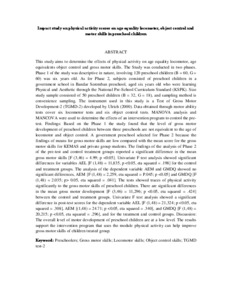Citation
S., Kavitha and Abdullah, Borhannudin and Yusof, Aminuddin
(2017)
Impact study on physical activity scores on age equality locomotor, object control and motor skills in preschool children.
International Journal of Education and Training, 3 (1).
pp. 1-6.
ISSN 2462-2079
Abstract
This study aims to determine the effects of physical activity on age equality locomotor, age equivalents object control and gross motor skills. The Study was conducted in two phases. Phase 1 of the study was descriptive in nature, involving 120 preschool children (B = 60, G = 60) was six years old. As for Phase 2, subjects consisted of preschool children in a government school in Bandar Seremban preschool, aged six years old who were learning Physical and Aesthetic through the National Pre-School Curriculum Standard (KSPK). Size study sample consisted of 50 preschool children (B = 32, G = 18), and sampling method is convenience sampling. The instrument used in this study is a Test of Gross Motor Development-2 (TGMD-2) developed by Ulrich (2000). Data obtained through motor ability tests cover six locomotor tests and six object control tests. MANOVA analysis and MANCOVA were used to determine the effects of an intervention program to control the pre-test. Findings: Based on the Phase 1 the study found that the level of gross motor development of preschool children between three preschools are not equivalent to the age of locomotor and object control. A government preschool selected for Phase 2 because the findings of means for gross motor skills are low compared with the mean score for the gross motor skills for KEMAS and private group students. The findings of the analysis of Phase 2 of the pre-test and control treatment groups reported a significant difference in the mean gross motor skills [F (3,46) = 4.99; p <0.05]. Univariate F test analysis showed significant differences for variables AEL [F (1,48) = 11,835, p <0.05, eta squared = .198] for the control and treatment groups. The analysis of the dependent variable AEM and GMDQ showed no significant differences, AEM [F (1,48) = 2,259, eta squared = P.045; p <0.05] and GMDQ [F (1,48) = 2.035; p> 0.05, eta squared = .041]. The tests showed traces of physical activity significantly to the gross motor skills of preschool children. There are significant differences in the mean gross motor development [F (3,46) = 11,296; p <0.05, eta squared = .424] between the control and treatment groups. Univariate F test analysis showed a significant difference in post-test scores for the dependent variable AEL [F (1,48) = 21,324; p <0.05, eta squared = .308], AEM [(1,48) = 24.71; p <0.05, eta squared = .340], and GMDQ [F (1,48) = 20,215; p <0.05, eta squared = .296], and for the treatment and control groups. Discussion: The overall level of motor development of preschool children are at a low level. The results support the intervention program that uses the module physical activity can help improve gross motor skills of children treated group.
Download File
![[img]](http://psasir.upm.edu.my/59417/1.hassmallThumbnailVersion/Impact%20study%20on%20physical%20activity%20scores%20on%20age%20equality%20locomotor%2C%20object%20control%20and%20motor%20skills%20in%20preschool%20children.pdf)  Preview |
|
Text (Abstract)
Impact study on physical activity scores on age equality locomotor, object control and motor skills in preschool children.pdf
Download (39kB)
| Preview
|
|
Additional Metadata
Actions (login required)
 |
View Item |

